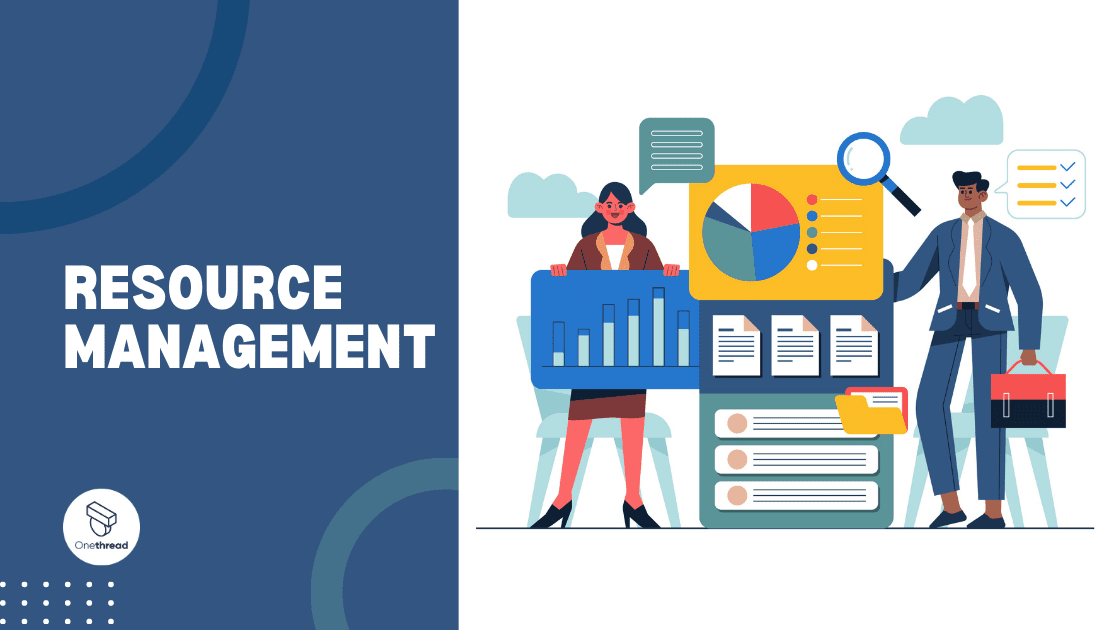Have you ever wondered how businesses and organizations efficiently handle their resources? Well, you’re in the right place! In this article, we’ll dive into the fascinating world of resource management and unravel its secrets.
So, what is resource management, you ask? It’s all about effectively allocating and utilizing the various assets at our disposal to achieve our goals. Whether it’s managing people, time, finances, equipment, or even natural resources, resource management helps us make the most out of what we have.
We’ll explore the key principles, strategies, and tools that can help us optimize resource allocation, enhance productivity, and drive success. Get ready to discover the art and science of resource management, and unlock the potential for greater efficiency and effectiveness in your own endeavors. Let’s jump right in!
What Is Resource Management? – The Definition
Resource management is the practice of strategically planning, allocating, and utilizing various assets within a working organization to achieve desired outcomes efficiently. It involves identifying and optimizing the use of resources such as human capital, time, finances, equipment, HR software, and materials
By effectively managing resources, businesses and organizations can ensure that the right resources are available at the right time and in the right quantities. Resource management encompasses processes, tools, and techniques that enable effective planning, scheduling, tracking, and coordination of resources throughout their life cycle.
It aims to maximize productivity, minimize waste, and ultimately drive success by ensuring that resources are utilized optimally to meet organizational objectives.
Why Do You Absolutely Need Resource Management?
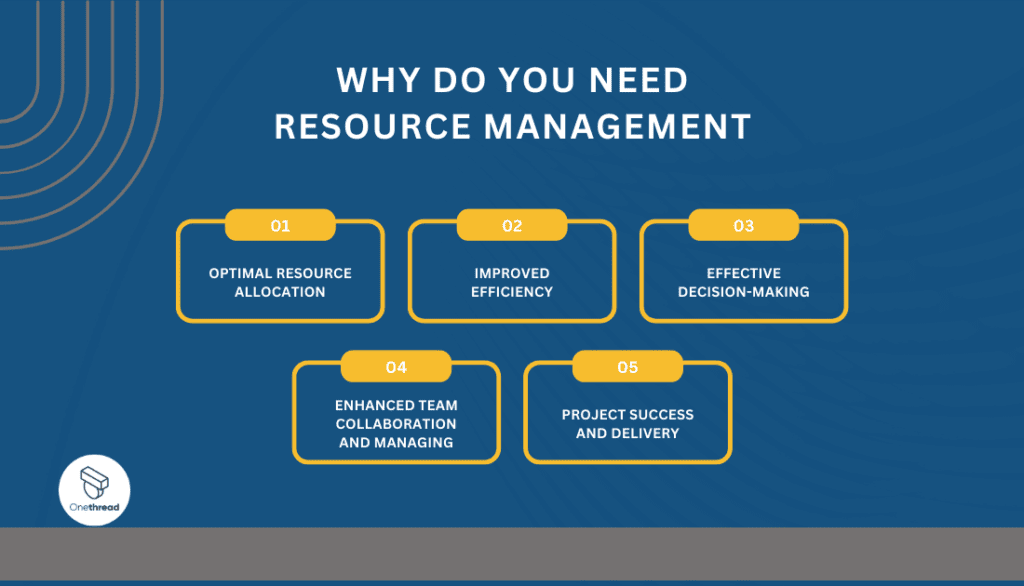
When it comes to achieving your goals and running a successful operation, resource management plays a crucial role. Here are a few reasons why resource management is an absolute must:
Optimal Resource Allocation
Resource management helps you make the most out of the resources at your disposal. By effectively allocating your resources, you ensure that each asset is utilized in a way that maximizes productivity and minimizes waste of products and workforce. So, you can start achieving more with less, saving both time and money.
Improved Efficiency
By strategically planning and coordinating your resources, you can streamline your operations and improve overall efficiency. Resource management allows you to identify bottlenecks, optimize workflows, and eliminate redundancies.
Effective Decision-Making
Having a clear overview of your resources enables you to make informed decisions. Resource management provides valuable insights into resource availability, utilization rates, and performance metrics from the start.
With this information, you can make data-driven decisions, allocate resources effectively, and adapt to changing circumstances promptly.
Enhanced Team Collaboration and Managing
Resource management fosters collaboration within your team. By having a centralized system to manage resources, you can guide and improve communication, coordination, and visibility.
Project Success and Delivery
Effective resource management is essential for project success. It allows you to allocate the right resources to the right tasks at the right time, preventing resource shortages or overloads. This ensures that projects stay on track, deadlines are met, and deliverables are achieved with high quality.
What Are the Different Types of Resource Management?
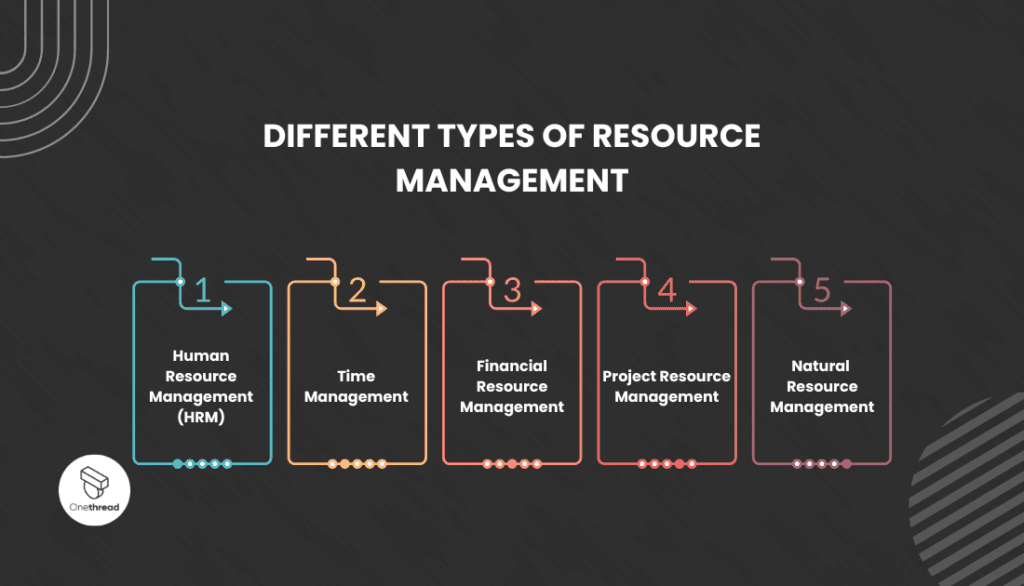
Resource management encompasses various types of resources that organizations need to effectively manage. Here are a few key types of resource management:
- Human Resource Management (HRM)
HRM focuses on managing the human capital within an organization. It involves activities such as recruitment, training, performance management, and employee development. Streamline your HR efforts with a targeted HR contact database. This resource helps connect you with qualified professionals, enhancing recruitment and training. Effective HRM ensures that the right workforce with the right skills are in the right roles, promoting employee engagement, productivity, and satisfaction.
- Time Management
Time management is all about optimizing the allocation and utilization of time. It involves prioritizing tasks, setting deadlines, and managing schedules to maximize productivity and meet project or organizational goals. Effective time management helps individuals and teams stay organized, minimize procrastination, and improve overall efficiency.
- Financial Resource Management
Financial resource management involves handling and allocating financial resources, such as budgeting, forecasting, and financial planning. It includes managing revenue, expenses, investments, and cash flow to ensure financial stability, profitability, and growth.
- Project Resource Management
Project resource management focuses on managing resources specific to projects, including personnel, equipment, materials, and budgets. It involves resource allocation, design schedules, and coordination to ensure that projects are adequately resourced and completed on time and within budget.
- Natural Resource Management
Natural resource management deals with the sustainable and responsible use of natural resources such as land, water, forests, and minerals. It involves conservation, preservation, and efficient utilization of these resources to meet present and future needs while minimizing environmental impacts.
The Cost of Inefficient Resource Management
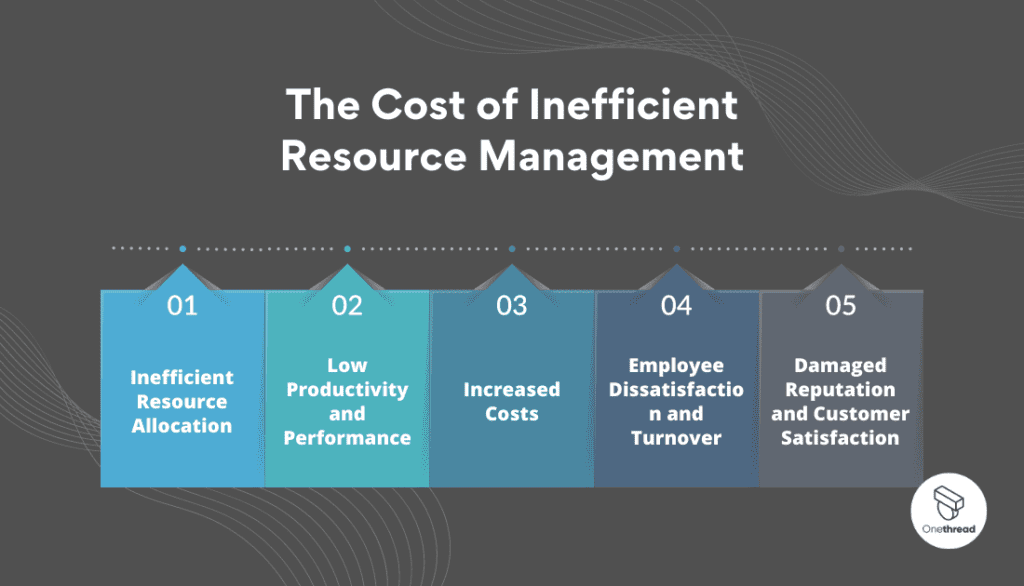
When resource management falls short, it can have significant consequences for organizations. Here are some key costs associated with inefficient resource management:
Inefficient Resource Allocation
Inadequate resource allocation can result in wasted resources or shortages in critical areas. This leads to inefficiencies, missed opportunities, and increased costs. Poor resource allocation can also impact project timelines, delay deliverables, and hamper overall productivity.
Low Productivity and Performance
A lack of proper resource management can lead to low productivity and underperformance. When resources are misaligned or underutilized, employees may struggle to complete tasks effectively.
It can result in decreased output, quality issues, and missed targets, ultimately affecting the bottom line.
Increased Costs
Poor resource management can lead to increased costs in various ways. Inefficient use of time and labor can result in overtime expenses or the need to hire additional staff. Ineffective financial resource management can lead to overspending or missed financial targets.
Employee Dissatisfaction and Turnover
When resources are poorly managed, it can lead to employee dissatisfaction and burnout. Inadequate staffing, excessive workloads, or lack of necessary tools can negatively impact employee morale and engagement. This can ultimately lead to increased turnover rates, recruitment costs, and the loss of valuable talent.
Damaged Reputation and Customer Satisfaction
Poor resource management can affect customer satisfaction and damage an organization’s reputation. Delays, quality issues, or inability to meet customer demands can result in unhappy clients, negative reviews, and loss of business opportunities.
What Are the Stages of Resource Management?
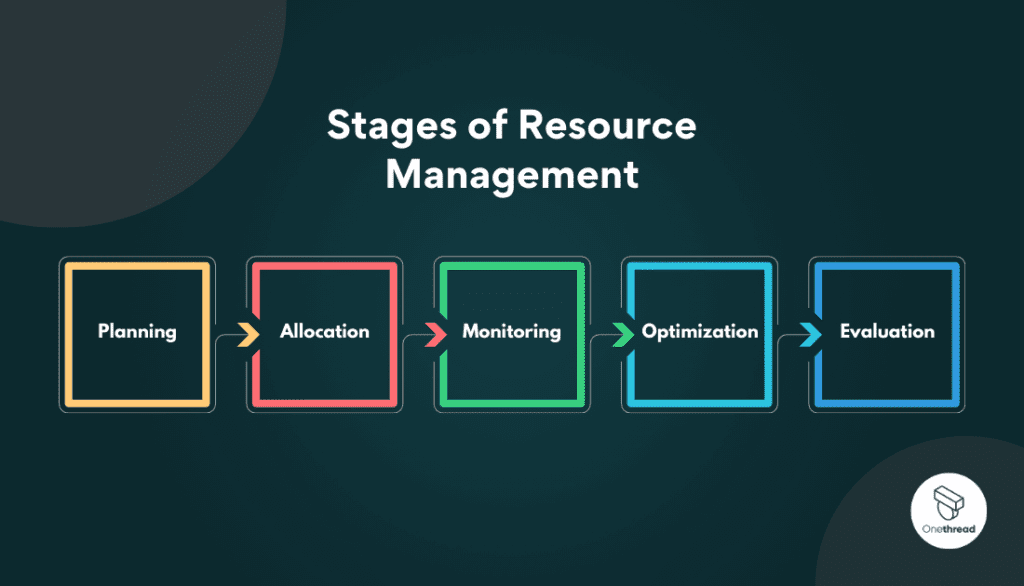
Effective resource management typically involves several key stages that help organizations optimize their in-house resource allocation and utilization. Here are the typical stages of resource management:
- Planning
The planning stage involves assessing organizational goals, project requirements, and resource needs. It includes defining objectives, identifying the types and quantities of resources required, and establishing timelines and priorities.
- Allocation
Once the planning stage is complete, the next step is resource allocation. This involves assigning resources to specific tasks, projects, or departments based on their availability, skills, and suitability. The process of allocating resources to complete projects efficiently and effectively saves your time and cost.
- Monitoring
Resource monitoring is an ongoing process that involves tracking resource utilization, project performance, and progress. It includes gathering data, analyzing resource usage, and comparing it against planned allocations.
With monitoring, organizations can identify any gaps, bottlenecks, or areas of improvement and take corrective actions as needed.
- Optimization
Optimization focuses on fine-tuning resource allocation to achieve the best possible outcomes. It involves adjusting resource assignments, reallocating resources based on changing needs, and optimizing workflows to enhance productivity and efficiency.
- Evaluation
The final stage is resource evaluation, which involves assessing the effectiveness and impact of resource management efforts. For resource managers, this includes analyzing key performance indicators, evaluating project outcomes, and gathering feedback from stakeholders.
How to Build a Resource Plan? Effective Planning of Resources
Resource planning is a crucial aspect of effective resource management. It involves creating a resource plan that outlines how resources will be allocated and utilized to meet project or organizational goals. Here are some steps to help you build an effective resource plan:
Identify Resource Requirements and Popular Skills
Start by identifying the specific resources needed for your project or operations. This includes considering personnel with skills, equipment, materials, and budgetary needs. Be thorough and ensure you have a clear understanding of the resources required to accomplish your objectives.
Assess Resource Availability
Evaluate the availability of your resources. Determine if you have the necessary personnel with the required skills, materials, and equipments. Take into account any constraints, such as resource availability at specific times or limited budgetary allocations.
Prioritize and Allocate Resources
Once you have a clear understanding of your requirements and availability, prioritize your resources based on criticality. Allocate the resources to different projects or tasks based on their priority, importance, and the project timeline. Consider the skills and expertise needed for each task when assigning personnel.
Consider Resource Constraints and Dependencies
Identify any constraints or dependencies that may impact resource allocation. This includes considering factors such as resource availability, potential conflicts, or interdependencies among tasks or projects. Ensure conflict minimization and efficiency maximization by allocating resources in the most effective way possible.
Regularly Review and Update the Plan
Resource planning is not a one-time activity. Regularly review and update your resource plan to account for changes in project scope, resource availability, or unexpected challenges. This allows you to adapt and make necessary adjustments to ensure optimal resource utilization.
Best Resource Management Techniques
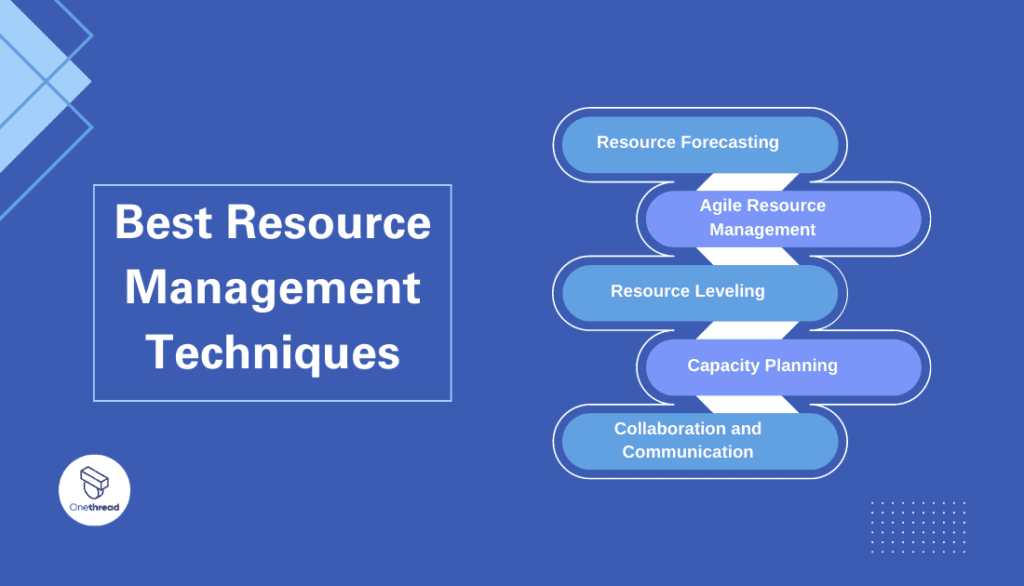
When it comes to resource management, there are many techniques that can help optimize resource allocation and utilization. Here are a few of the best techniques to consider:
Resource Forecasting
Resource forecasting involves predicting future resource needs based on historical data, project requirements, and expected growth. By accurately forecasting resource demand, you can proactively plan and allocate your resources, avoiding shortages or overloads.
Agile Resource Management
Agile methodologies, such as Scrum or Kanban, promote flexibility and adaptability in resource management. They involve iterative planning, continuous collaboration, and frequent reassessment of resource needs.
Agile approaches enable you to quickly respond to changing project requirements and allocate resources accordingly.
Resource Leveling
Resource leveling aims to balance the demand and availability of resources over time. It involves adjusting schedules and task assignments to minimize resource conflicts and ensure a smooth workflow for the employee.
Capacity Planning
Capacity planning involves assessing the capacity and capabilities of your resources. It helps identify potential bottlenecks or areas where additional resources may be required.
With instructions planview, you can prevent delays, optimize productivity, and make informed decisions about resource allocation.
Collaboration and Communication
Effective collaboration and communication among team members and stakeholders are essential for resource management. Establish clear channels for sharing information, coordinating tasks, and addressing resource-related issues.
Regular communication ensures that everyone is on the same page, resource conflicts are resolved, and resource allocation remains aligned with project objectives.
How to Find the Best Resource Management Software?
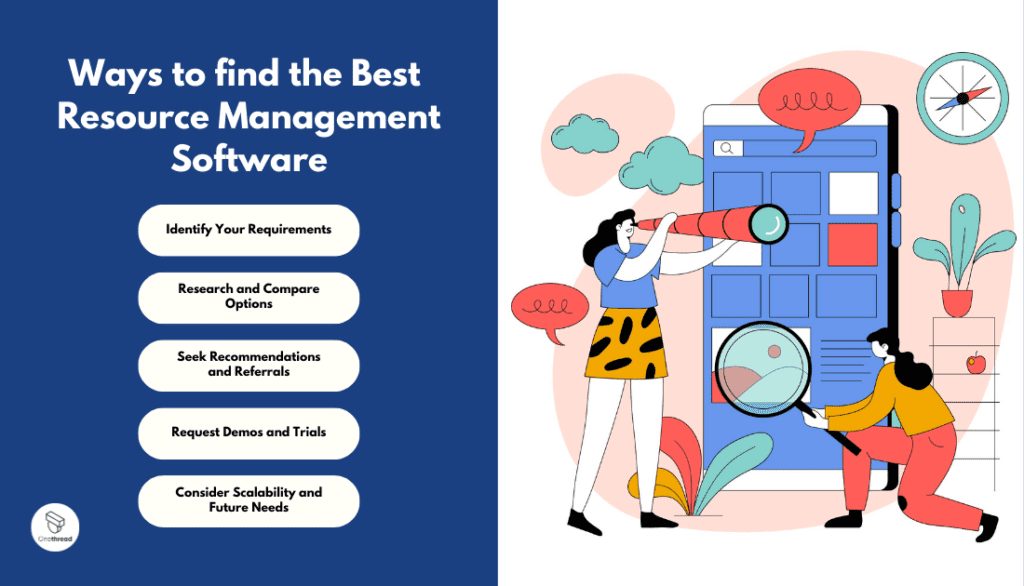
Finding the right resource management software can greatly enhance your organization’s ability to effectively allocate and utilize resources. Here are some tips to help you find the best resource management software for your needs:
Identify Your Requirements
Start by clearly defining your resource management needs. Consider the specific features and functionalities you require, such as resource allocation, scheduling, collaboration, reporting, or integration capabilities. This will help you narrow down your options and focus on software that aligns with your requirements.
Research and Compare Options
Conduct thorough research to identify different resource management software options available in the market. Read reviews, explore vendor websites, and compare features, pricing, and customer feedback.
Seek Recommendations and Referrals
Reach out to peers, industry associations, or online communities to seek recommendations and referrals. Ask for their experiences with resource management software and gather insights on the pros and cons of different solutions.
Request Demos and Trials
Request demos or free trials from shortlisted software providers. This allows you to experience the software firsthand and evaluate its usability, functionality, and user interface. Make sure to involve key stakeholders in the evaluation process to gather diverse perspectives.
Consider Scalability and Future Needs
Choose a resource management software that can scale with your organization’s growth and evolving needs. Consider factors such as the number of users, project complexity, and the ability to handle increased resource demands. Future-proofing your choice ensures that you won’t outgrow the software quickly.
Why You Should Try Onethread As Your Resource Management Tool
Onethread stands out as a powerful resource management tool due to several key features that contribute to its effectiveness and user-friendly approach:
Customizable Workflows:
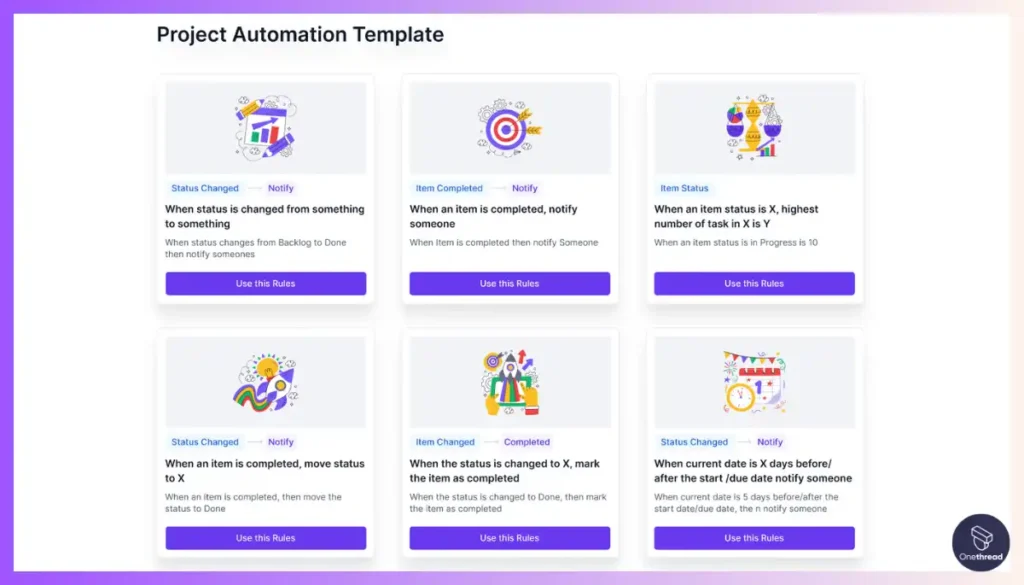
Onethread allows you to design and automate workflows that can be tailored to your specific business needs. This means you can adapt the tool to match your organization’s unique processes and requirements, enhancing resource allocation and project management.
Task Management:
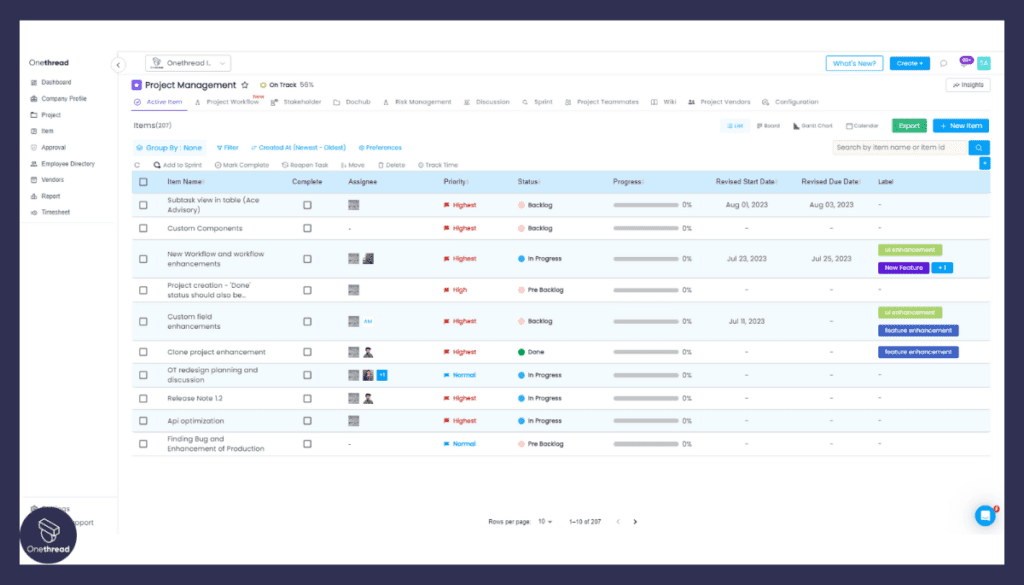
With Onethread, you can easily assign tasks, set deadlines, and track progress all in one place. This streamlined task management process helps ensure that resources are allocated appropriately and projects stay on track.
Visualized Task Management:
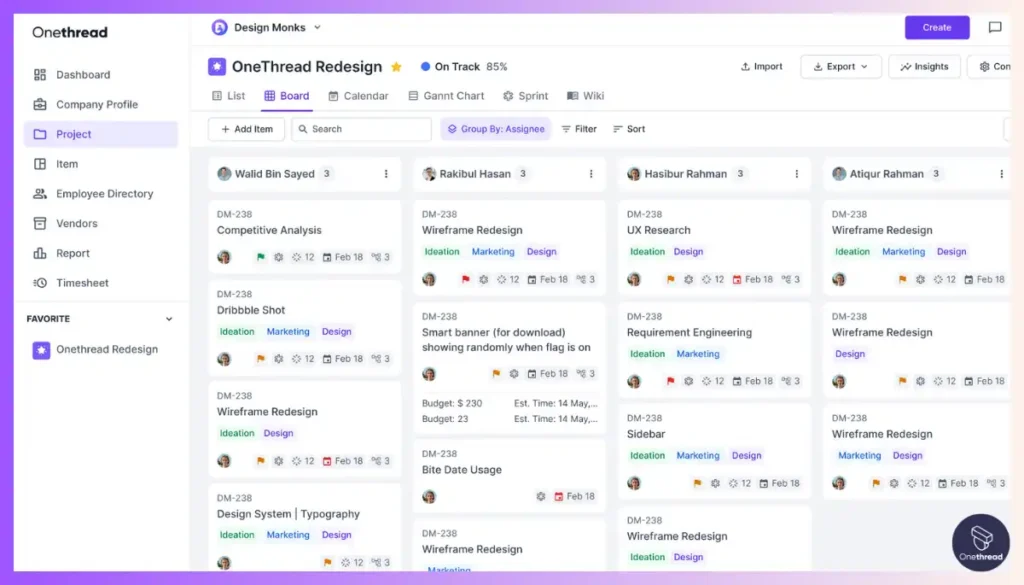
Onethread provides visual tools like Kanban boards, calendar views, and Gantt charts. These visualizations allow for easy monitoring of tasks, phases, and milestones, helping you effectively allocate resources and manage project timelines.
Collaboration Tools:
The platform offers features for real-time communication and collaboration among team members. This fosters efficient teamwork, allowing for better coordination of resources and sharing of information.
Dashboard:
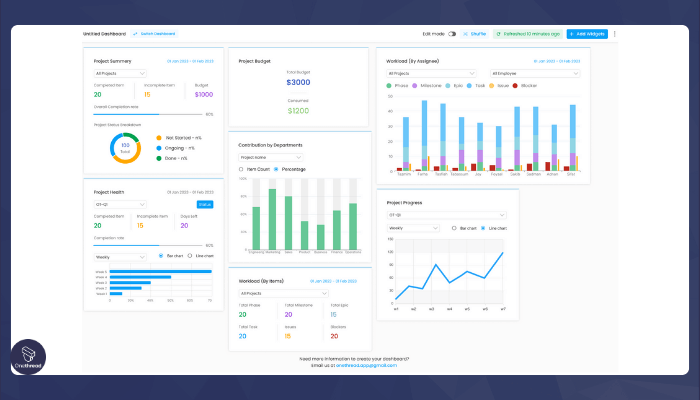
The ability to create customized dashboards provides a clear overview of relevant information. This feature enhances resource management by offering quick insights into project status, task assignments, and overall progress.
Role Permissions:
Onethread allows you to customize access levels for team members, ensuring data security and efficient collaboration. This feature is crucial for managing resource access and ensuring the right people have the necessary information.
Time Tracking:
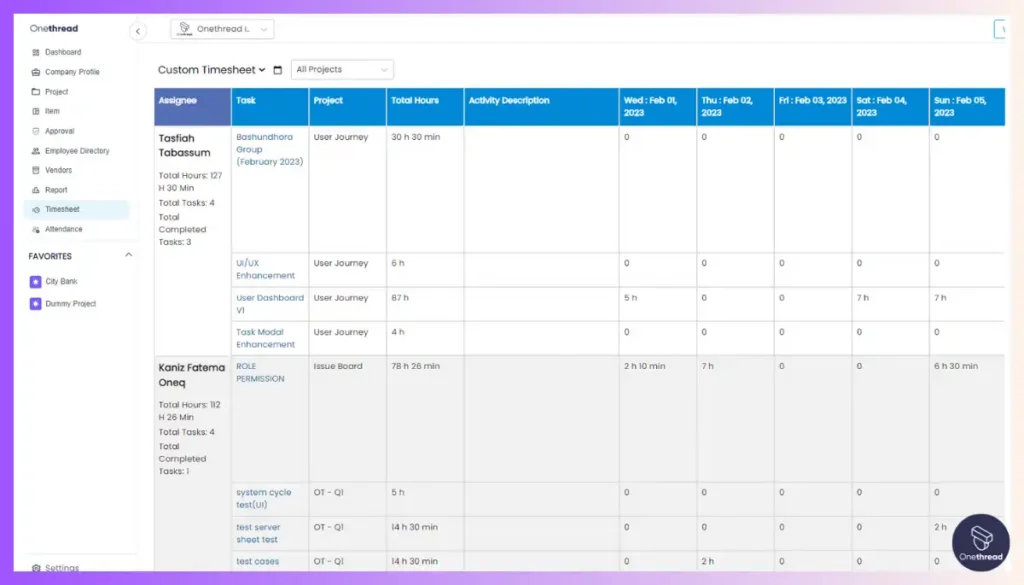
The inclusion of a timesheet feature enables you to track time spent on tasks and generate comprehensive reports. This data can help you better understand how resources are utilized and identify areas for optimization.
Flexibility:
Onethread’s customizable nature ensures that it can adapt to various industries and project types, making it a versatile resource management tool suitable for different organizations.
User-Friendly Interface:
The tool’s intuitive design makes it easy for both project managers and team members to use. This user-friendly interface contributes to effective resource management and collaboration.
Top 5 Resource Management Best Practices to Boost Your Career
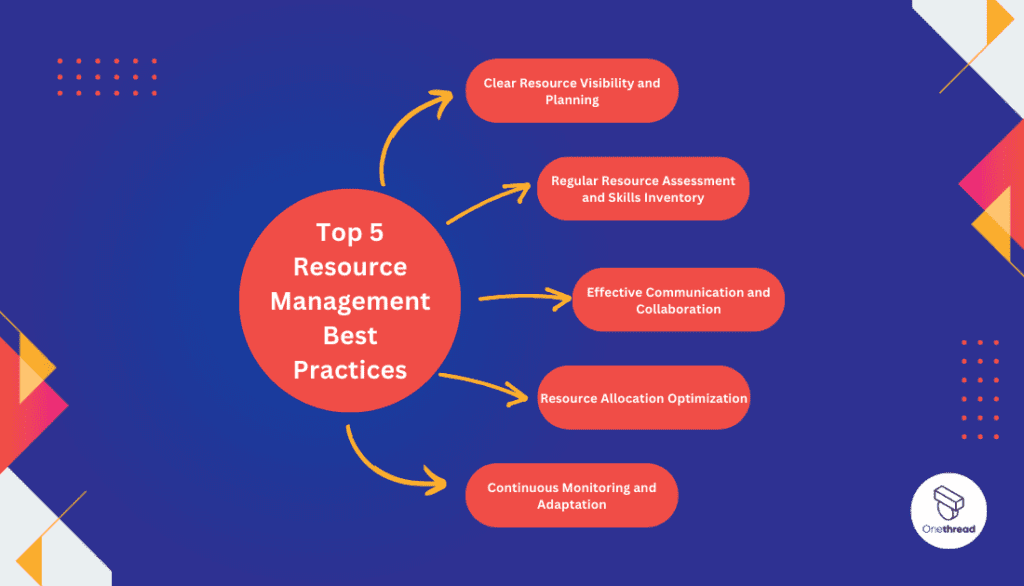
Implementing resource management best practices can significantly improve your organization’s efficiency and productivity. Here are five top practices to consider as a resource manager:
Clear Resource Visibility and Planning
Maintain a centralized system or tool that provides a clear view of your available resources, their utilization rates, and upcoming demands. Such a management guide allows you to effectively plan and allocate resources based on real-time data, preventing overbooking or underutilization.
Regular Resource Assessment and Skills Inventory
Conduct regular assessments of your resources, including personnel skills, certifications, and expertise. Maintain an up-to-date skills inventory that helps identify gaps or areas for improvement. This ensures that the right resources are assigned to the right tasks, maximizing efficiency and avoiding unnecessary delays while working as a team.
Effective Communication and Collaboration
Promote open and effective communication among team members and stakeholders. Encourage collaboration and knowledge-sharing to optimize resource utilization. Clear communication channels facilitate coordination, minimize conflicts, and ensure that everyone has the necessary information for efficient resource management.
Resource Allocation Optimization
Optimize resource allocation by considering factors such as resource availability, working skills, and workload. Balance resource assignments to avoid overloading certain team members while underutilizing others. Regularly review and adjust resource allocations based on project priorities and changing requirements.
Continuous Monitoring and Adaptation
Implement a system for continuous monitoring of resource utilization, project progress, and performance metrics. Regularly assess resource allocation effectiveness and make necessary adjustments. This allows you to adapt to changing circumstances, optimize resource usage, and identify areas for improvement.
Bottom Line
That was all about what is resource management. In short, resource management is the backbone of efficient and successful operations, whether it’s in business, projects, or personal endeavors.
It empowers us to make the most out of our resources, ensuring they are allocated strategically and utilized optimally. By implementing resource management principles, we can streamline workflows, enhance productivity, and achieve our goals effectively.
From human resources to time, finances, projects, and natural resources, resource management provides us with the tools and techniques to maximize efficiency and drive success.
